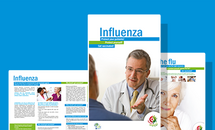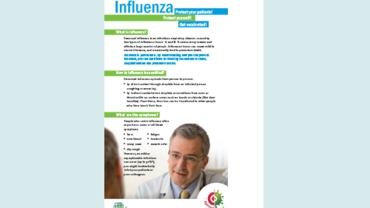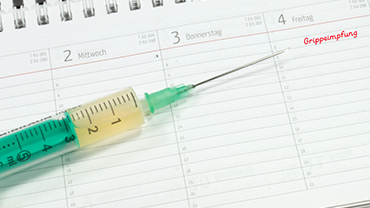Influenza communication guide: How to increase influenza vaccination uptake and promote preventive measures to limit its spread
The influenza vaccination communication guide provide advice, guidance and campaign materials to support national influenza vaccination campaigns with the purpose of increasing the influenza vaccination uptake in the EU Member States.
Download
About the guidelines
Support to national communication campaigns
The communication guidelines contains different types of campaign material (logotype, pins, posters, leaflets, factsheets, banners) to support national communication campaigns on seasonal influenza.
The material provides priority audiences with information on seasonal influenza and the benefits of vaccination, and is designed to ensure that consistent and clear messages are conveyed to the audiences effectively.
The guidelines aim to provide support for national health professionals who are responsible for planning and developing communication activities on influenza prevention. The campaign material can be translated or adapted to cultural specificities and campaign focus.
The files are provided in:
- PDF flattened format for easy reproduction: this format can be used to view the material and for printing purposes;
- Adobe InDesign and Illustrator formats for professional use: this format can be used to modify the layout and/or the text;
- Word files and “PDF for translation”: this format can be used to facilitate translation in your language.
Priority audiences
An important element of any health communication strategy is to identify and know priority audiences and to adapt the information and its presentation to their needs and level of knowledge on the specific topic, as well as their attitudes and perceptions.
The materials included in this guidelines are designed to direct key messages on seasonal influenza and its prevention at two specific, pre-identified audiences for whom information on influenza and preventive measures can be particularly relevant:
- Healthcare professionals (HCPs): They are key players in advising and delivering influenza vaccination. Despite being widely recommended, influenza immunisation coverage among healthcare workers is very low in EU and EEA countries.
- Risk groups: High-risk groups such as elderly people (often defined as 65 years and over) and those suffering from chronic diseases are at higher risk of serious flu-related complications.
In recognition of the varying level of prior knowledge and opportunities for responding to the threat of seasonal influenza among these groups, the materials have been adapted, while preserving consistency in the messaging. Specific materials have been pre-tested in focus group studies and then revised by communication experts, taking into consideration the inputs of the focus group and the most recent evidence-based studies on communicating health issues.These materials are intended to deliver clear and simple messages in a visually interesting way in order to capture the audience’s attention.
Targeted material
Material targeting HCPs
The aim of communications targeting healthcare practitioners is to encourage healthcare professionals to get immunised against seasonal influenza every year. Based on a systematic literature review on effective immunisation campaigns and the latest social marketing theories, instead of highlighting the benefits of vaccination it was decided to focus on risk-taking behaviour, acknowledging existing fears and sharing information on the risks associated with vaccination.
Material targeting risk groups
The aim of health communication targeting risk groups is to create a significant level of awareness and understanding of the risks associated with seasonal influenza and the importance of taking the right preventive measures, in particular vaccination.
Campaign materials
1. Logotype
A logotype (‘Against the flu’) depicting a stylised influenza virus on a red target has been developed as a visual link for all the materials in the toolkit. The logotype can be used in conjunction with national initiatives at various events.
1.1 Download the logotype
2. Pins
The logo can be used for the production of pins. The toolkit includes the files needed for the production of 25 x 25 mm format pins. The text on the pin ’Against the flu’ can be translated into local languages.
The logo developed for the ECDC influenza toolkit can be also used for other initiatives. For example, HCPs can wear a pin as a testimonial of commitment, expressing their support to vaccination and encouraging other HCPs and patients to immunise themselves against flu. The pins can be distributed to hospital and healthcare personnel.
3. Posters
The poster presents basic facts on influenza and key preventive messages which can be read and understood quickly. More detailed content can be made available to target audiences via factsheets and brochures but can also appear on websites and in other materials.
3.1 Posters targeting healthcare professionals
The prototype sheets which can be used as posters provide key information on HCP immunisation and slogans explaining its importance. They are intended for display in HCP working areas such as:
- Hospitals
- Healthcare facilities
- Professional journals, health-related magazines and newspapers
3.2 Posters targeting risk groups
The prototype sheets which can be used as posters provide key information on the importance of influenza vaccination. They are intended for display in venues that provide a link to the local community or where citizens may seek health advice such as:
- Healthcare facilities
- Doctors’ waiting rooms
- Pharmacies, community centres, libraries, etc
3.3 Download the posters - for print or translation
3.4 Influenza during the COVID-19 pandemic
-
How do I protect myself and others from COVID-19 during influenza vaccination?
-
Why is it important to get vaccinated against influenza during the COVID-19 pandemic?
4. Factsheets
The two-page factsheets (130 x 250 mm) provide key information presented very synthetically. Although they contain more text than the poster, the information is nevertheless easy to understand and is useful for addressing an audience (e.g. where people are seated or waiting).
4.1 Factsheet targeting healthcare professionals
This provides key information on seasonal influenza. In terms of dissemination, it is advisable to explore channels and venues that offer a natural link to the healthcare professional community such as:
- Direct mailing to hospitals/practicing doctors
- Professional websites and journals (online and print versions)
- Healthcare symposiums/events
4.2 Factsheet targeting risk groups
The two-page information sheet provides key information on seasonal influenza. It can be distributed at the following venues:
- General practitioners’ offices
- Pharmacies
- Healthcare facilities
- Doctors’ waiting rooms
If deemed appropriate, it could also be sent by local health authorities as a direct mailshot to households with a letter explaining the risks associated with seasonal influenza.
4.3 Download the factsheets - for print or translation
5. Leaflets
The four-page draft leaflets (180 x 297mm each page) provide detailed information on influenza, vaccination and – in the case of risk groups – on preventive hygiene messages. The leaflets are intended for audiences, where an interested individual has time to read through the material. They may require some professional adaptation.
5.1 Leaflet targeting healthcare professionals
The four-page leaflet provides information on the seriousness of the disease, its symptoms and the reasons why it is important for HCPs to be immunised. It can be distributed at the following venues:
- Hospitals
- Healthcare facilities
- General practitioners’ offices
5.2 Leaflet targeting risk groups
The four-page leaflet provides information on the seriousness of the disease, its symptoms and the reasons why it is important to get vaccinated. In terms of dissemination, it is advisable to explore channels and venues that provide a link to the local community or where citizens may seek health advice, such as:
- Health facilities
- Doctors’ waiting rooms
- Pharmacies
- Community centres
- Health websites
5.3 Download the leaflets - for print or translation
6. Web banners and buttons
Banners can be included in web page structures for the entire influenza season or as part of a post or feature article.
6.1 Web banners targeting healthcare professionals
Web banners can help promote influenza awareness among HCPs by directing readers to valuable information. They can be published on the websites of national bodies such as:
- Ministries of Health
- National health boards and institutes
- Healthcare-related professional associations
- All other bodies sought for advice by healthcare professionals
6.2 Web banners targeting risk groups
A web banner is a great way to promote influenza awareness while directing readers to targeted information. It can be published on the following websites:
- Patients associations
- National health bodies and institutes
- Online health-related journals and newspapers
- All other bodies visited by the general public and people suffering from chronic health conditions
6.3 Download the banners
7. Social media materials targeting healthcare professionals
Social media materials shared on mediums such as Facebook and Twitter can help promote influenza awareness among healthcare professionals. They can be shared through the social media channels of national bodies such as:
- Ministries of Health
- National health boards and institutes
- Healthcare-related professional associations
- All other bodies sought for advice by healthcare professionals
7.1 Download the material
How to use the toolkit
The toolkit includes templates of all available materials. The templates are available as Adobe InDesign files that can be modified using InDesign version 5.5. The individual graphics and fonts are also attached separately for easy application.
Graphics
The graphics used for the toolkit are all in a resolution of 300 dpi and in a CMYK colour range. The files are provided in InDesign extension format.
The colours of the graphic boxes are:
- Cyan blue: C100 M13 Y0 K0
- Green: C57 M0 Y100 K0
Fonts
The fonts used are Franklin Gothic and Meta Pro. These are fonts that can be adapted to suit various alphabets and specific characters. These fonts are normally included in most word processing systems but if not, they are also contained in a folder in the toolkit.
Fonts are used as follows:
- Title: Franklin Gothic Medium Cond
- Subtitle in boxes: MetaPro Bold
- Body Text: MetaPro.
The colours of the fonts are:
- Cyan blue: C100 M13 Y0 K0
- Green: C75 M5 Y100 K0
- White: C0 M0 Y0 K0
These materials can be adapted according to language, cultural differences and campaign focus.
Disclaimer and copyright notice
This toolkit and the prototype products are provided for information purposes only and should not be interpreted as official advice from ECDC.
This material has been created under a contract. ECDC is the copyright owner of the material created under contract, unless otherwise specifically indicated. In accordance with the copyright policy of the Centre, free use of the material for non-commercial purposes is allowed without need of prior authorization and as long as ECDC logo or reference is included. Please be aware that certain parts of the material are licensed under conditions to the ECDC and, therefore, the licensed material shall not be used outside the specific purpose of the campaign. If a private entity is involved in any way in organizing, sponsoring or supporting by any other means the campaign, please be aware that use of the material is allowed as long as the purpose of the event is non-commercial.
For further information and to send us a feedback on the influenza communication toolkit, please contact info@ecdc.europa.eu.
Read more on this site
More about this topic
Meeting report: Understanding the behavioural aspects and the role of health communication in mitigating the impact of seasonal influenza
The meeting report covers health communication strategies that could be undertaken to better promote influenza prevention measures and the healthcare professionals’ role in the uptake of seasonal influenza vaccination.
Seasonal influenza vaccines
Guidelines, information and data on vaccination for seasonal influenza.











